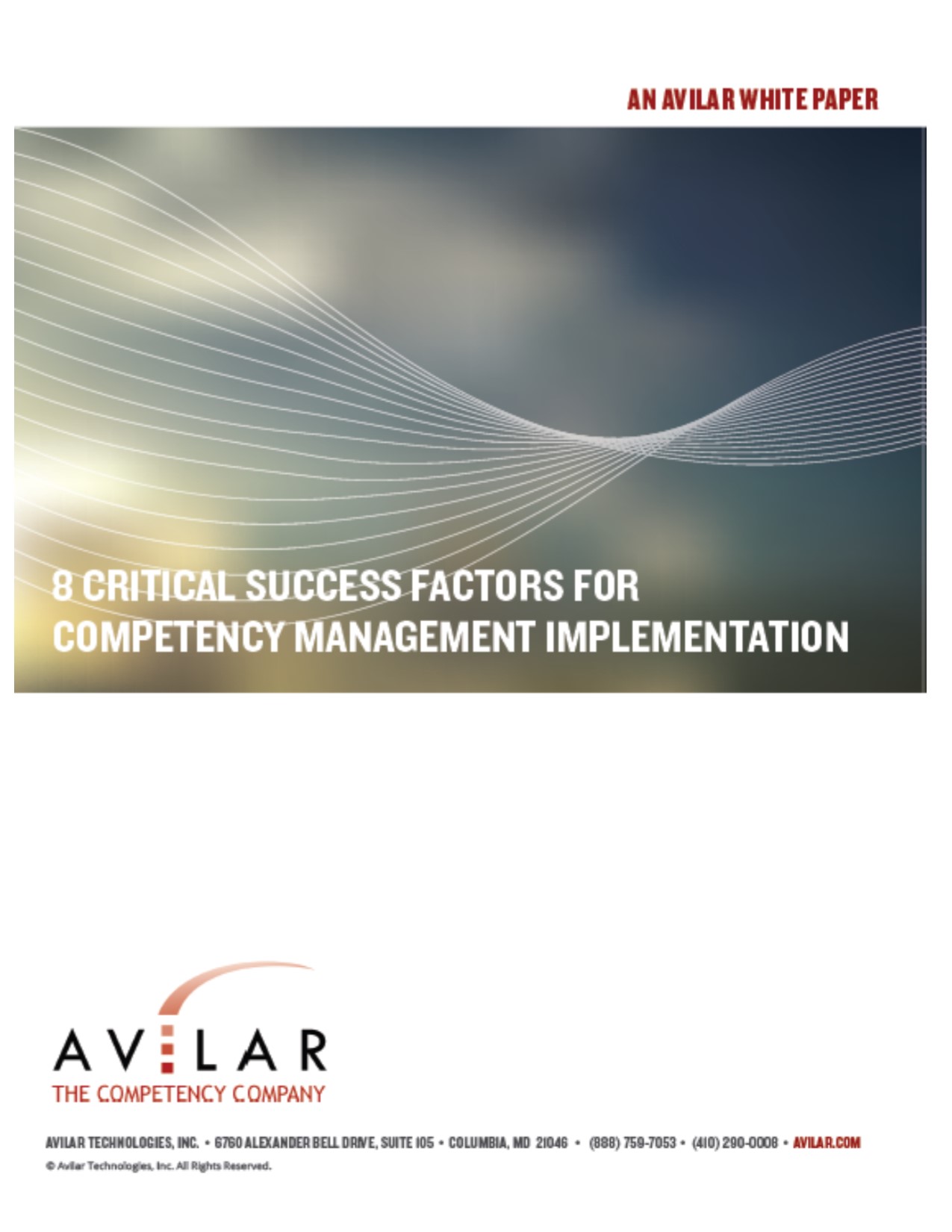Consider these 8 success factors for competency management and the likelihood that your company and key stakeholders are willing and able to adhere to them.
Competency management can be used in a variety of ways to benefit an organization. From recruitment to hiring to compensation to training, there is a broad spectrum of applications that can benefit from a solid competency management method.
Before embarking on the process of creating a competency management method, it is important to consider these 8 success factors and the likelihood that your company and key stakeholders are willing and able to adhere to them. Remember, competency management is not an exact science; it will work best if it is customized to your company’s goals and culture, if you understand the abundant return on your efforts, and if employees at all levels are fully committed to using it over the long term to make your organization more successful. Here are the critical success factors for competency management:
1. Recognize the Contributions of Highly Proficient Employees
We can all agree that an employee possessing higher proficiency in specific, job-related tasks is more likely to perform better than an employee with lower proficiency in those tasks. This is why it’s so important to match the skills required to perform a job with the skill proficiencies of an employee. The World Economic Forum’s (WEF) Global Agenda Council on Employment is also in agreement and produced a summary paper describing the negative economic effects worldwide caused by a mismatch of skills.
Yet the implementation of a competency management approach is necessary to understand whether each employee possesses the skill levels needed in their job role, and whether they can capitalize on them to deliver at a high performance level for the organization. While an employee’s performance may be described as “Above Average” on a performance evaluation, that does not necessarily mean they are the right person for that job. Perhaps another employee in a different department is a better fit. Therefore, they are performing well but not necessarily at a level that represents the greatest value to the organization.
When an organization considers what it can achieve if each employee is perfectly matched to their job, the potential for success is unhindered and unlimited.
2. Understand that Improved Job Performance Results in a Stronger Bottom Line
Many organizations have found that taking a consistent and systematic approach to categorizing and identifying skills among their organization’s employees is a giant leap forward. Most key stakeholders understand and accept that competency management is not a perfect science, but they also understand that data related to such categorization can be highly useful to the organization.
While the final identification of skill sets and the creation of a competency catalog for the jobs in an organization is, in itself, a huge accomplishment, the teamwork inherent to the process that creates that catalog can be even more beneficial to the organization. Ultimately, the in-depth knowledge resulting from the competency management process becomes a competitive advantage to that organization, advancing the organization’s hiring efficiency, candidate selection, management pipeline, and productivity.
3. Kill the Gossip Grapevine with Transparent Communication
The “gossip grapevine” can break this type of project. Some employees will be on board immediately, but others will grumble, gripe, and speculate about the “real” reasons behind the implementation of competency management. Even if only a few naysayers have their say, the project can be doomed before it has a chance to take root.
To allow it to take root, grow, and ultimately blossom in a positive way, a clear communications program is crucial. A simple, mass email to all employees will not suffice. Instead, the purpose for implementing competency management must be explained in some detail, along with the process to be applied, and the desired outcomes and expectations of the organization’s key stakeholders. Like any good marketing program, the messaging should be concise, clear, and consistent, emphasizing the purpose and end results in every message. It should convey the decision that competency management is here, and it’s here to stay, so “get on board.”
4. Build Your Foundation with Concrete (Data)
Team leaders and key stakeholders are more likely to see the project through to completion if they can build their efforts on a solid foundation. Numerous companies produce “competency dictionaries” that will provide a concrete foundation and formats upon which to build. And while the initial price may be unappealing, purchasing that foundation will jump-start the program and save hundreds of person-hours (and the associated costs) compared to starting the project from scratch.
Numerous industry associations, think tanks, universities, and management consulting firms have built generalized and/or industry-specific standards for common job roles. One example is the competency management skill sets developed for information technology organizations by the Employment and Training Administration of the U.S. Department of Labor. Organizations from software developers, to file server manufacturers, to IT consulting firms have been able to utilize these skill sets, customize and enhance them, and more quickly execute them in their organizations.
Read 4 Additional Success Factors for Competency Management by Downloading our Complete White Paper
 In lieu of developing competencies for every job role, some organizations have opted for creating a “snapshot” of competencies that are required for the majority of employees. In these cases, the project may require less programming and integration with legacy systems. However, companies that embed competencies into the annual development planning process are more highly motivated to integrate and therefore are more likely to reap long-term benefits from the effort put forth to develop the competencies and content.
In lieu of developing competencies for every job role, some organizations have opted for creating a “snapshot” of competencies that are required for the majority of employees. In these cases, the project may require less programming and integration with legacy systems. However, companies that embed competencies into the annual development planning process are more highly motivated to integrate and therefore are more likely to reap long-term benefits from the effort put forth to develop the competencies and content.
You may also consider procuring software tools to help you navigate through the process most efficiently. Avilar’s software – WebMentor Skills™ – can help your company identify, analyze, and manage skills gaps within your workforce. Contact us if you’d like to learn more.
In Summary
When your company has completed evaluating these 8 Critical Success Factors and has a better understanding of the return on effort, then it’s time to step back, look at the big picture, and consider your comfort level with them. If most or all of them feel comfortable and appear achievable, then it’s likely you’re prepared to persevere through them. However, the more discomfort that arises, the more seriously your organization should consider the effort to begin implementing competency management, and the long-term implications that decision will have – both positively and negatively.
A skills inventory leading to the creation of well-defined competencies can provide exponential benefits to an organization. Considering the investment that a company makes in salaries and benefits for its most important asset – its employees – it makes sense to invest in that asset and obtain the best return from it.


